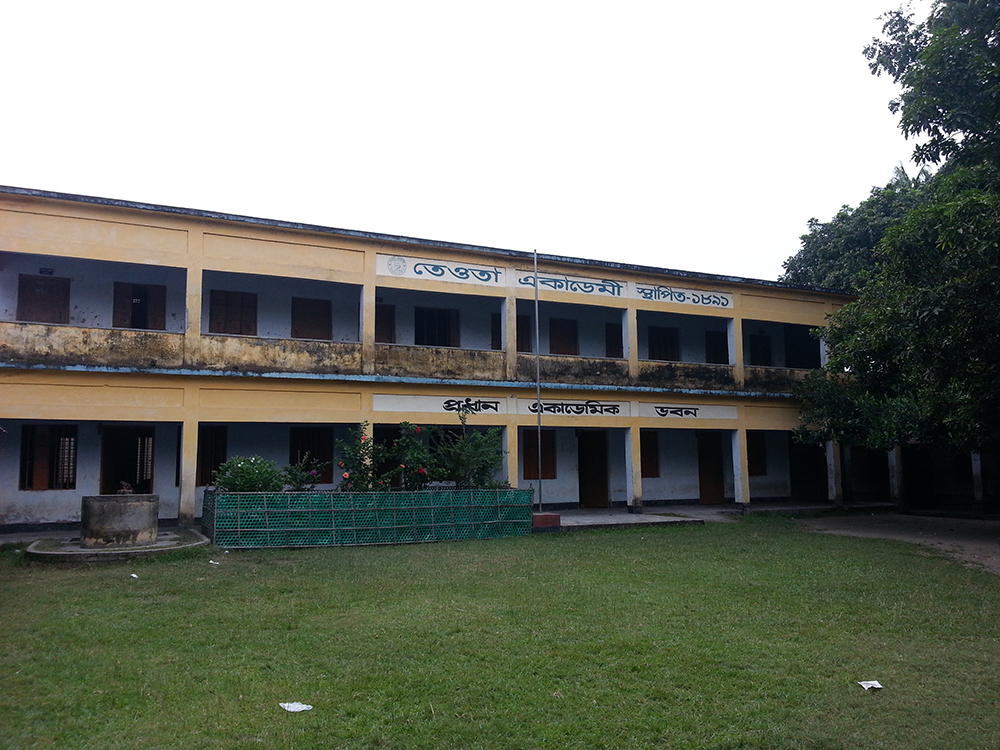প্রতিষ্ঠানের ইতিহাস

Three kilometres to the south is the ceaseless bustle of Aricha Ghat, where thousands of passengers and limitless cargo traverses the Padma River every day. At Aricha, one witnesses the hectic pulse of the modern Bangladeshi nation. Amid such frenetic activity, it's not easy to appreciate that just a stone's throw away, among the tranquil ruins of the 250-year-old Teota Palace a bygone era can yet be imagined.
Teota village on the Jamuna's banks in Manikganj's Shivalaya upazila was the seat of the influential Teota landlords, who in the nineteenth century administered one of eastern Bengal's largest estates. The palace built in a blend of European and Mughal styles isn't only their famed residence; it's where national poet Kazi Nazrul Islam met his wife Pramila Devi.
THE TEOTA ESTATE
The founder of the Teota lineage Panchanan Das Gupta, popularly known as Panchu Sen, was born in the 1740s. The family weren't landlords and Panchanan lost his father Anandiram Das Gupta at an early age.
Panchanan was first involved in the tobacco trade in Dinajpur, where he achieved some success. Subsequently, he invested in land and acquired eight significant landholdings in the Dinajpur region. When Panchanan returned to establish the Teota estate, he was already a wealthy man. In 1830, the Nayeb of Murshidabad granted him the title, Chowdhury.
Set on 10 acres, the palace today features a large tax house where taxes due to the landlord were once collected. There are two temples including an impressive navaratna temple, one of the tallest and finest of its kind. The site has two large ponds and a perimeter wall's remains.
Panchanan lived into his nineties; and subsequent generations secured a reputation for progressive governance, constructing roads, digging ponds and investing in innovation and education.
Such activities included the 1891 establishment of the Teota Academy, a residential high school within the palace complex that was likely the only school in the region outside Manikganj town. Attracting students from modern-day Bangladesh and India, many Teota graduates later pursued higher studies in Kolkata. The school still operates, though without residential facilities.
It was only after 1947 when the landlords left for Kolkata that the Teota dynasty ended.
A BRIDE FOR A REBEL POET
Cultural life at the palace was rich, with frequent visits from the subcontinent's leading literary figures. Among them was poet Kazi Nazrul Islam, who must've been well-appreciated by Panchanan's son Sankar Roy Chowdhury, as he was in the anti-British struggle.
On one visit Kazi Nazrul first noticed a Hindu girl, Ashalata Sen. Years later, on April 25, 1924, he married her, renaming his bride Pramila Devi.
According to Nazrul researcher Rafikul Islam, Pramila was born on May 10, 1908, to Basanta Kumer Sen and Giri Bala Sen who lived adjacent to the palace. Pramila's nicknames were alternately “Dolna” and “Duli”. She lost her father when about 12 years old and grew up with support from uncles Jagat Kumer Sen and Indra Kumer Sen.
It was after her father's death that her mother took her to live with her younger uncle Indra in Comilla's Chandirpar, where he was a court inspector.
Kazi Nazrul held deep affection for Teota. He loved the people and the river. Many poems and songs including “Nari”, “Lichu Chor”, “Chhoto Hitlar” were discovered as he sat overlooking the Jamuna.
Since 2008 several organisations have hosted programmes observing the birth and death anniversaries of both Kazi Nazrul and Pramila at Teota.
In 2015, the Nazrul Institute held its three-day Jatiya Nazrul Sammelon festival there, with attendees including the culture minister, director-general of the Nazrul Institute, researchers, artistes, litterateurs and thousands of the poet's admirers. Kazi Nazrul's family members have also attended functions there.
In recent years the people of Manikganj have advocated for the construction of a Nazrul-Pramila Institute, a university, a library and a memorial. The government has taken some action to renovate the site's Navaratna Math; the prime minister announced a museum dedicated to Kazi Nazrul and Pramila will be constructed.
But according to the Teota Academy's head teacher Mojammel Haque, the president of the Nazrul Pramila Institute Babul Akter Monju and Nazrul researcher Rafikul Islam, progress on developing the site has been slow. They hope all of the aforementioned institutions can be established.
Scenic Teota is often used as a backdrop by filmmakers, who find in the area perhaps, the same beauty that once inspired Kazi Nazrul. Three kilometres to the south, meanwhile, in the hubbub of Aricha it's easy to understand how Teota's heritage can be lost in modernity's noise. At the national level, it would do well to remember, because Teota's is a legacy worth celebrating.

